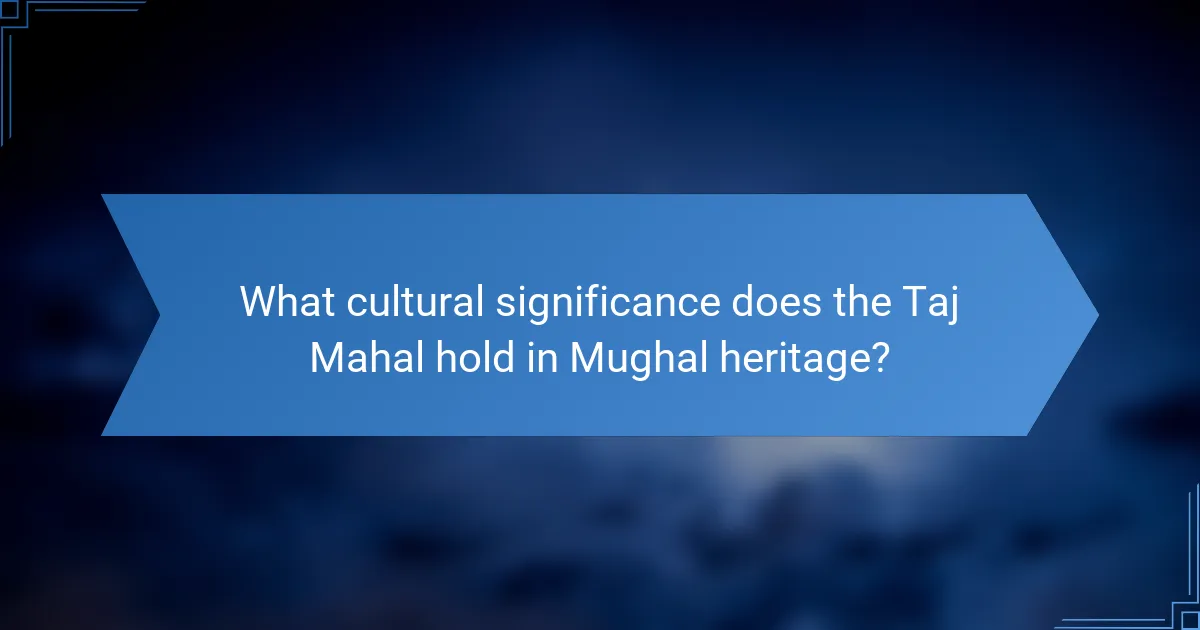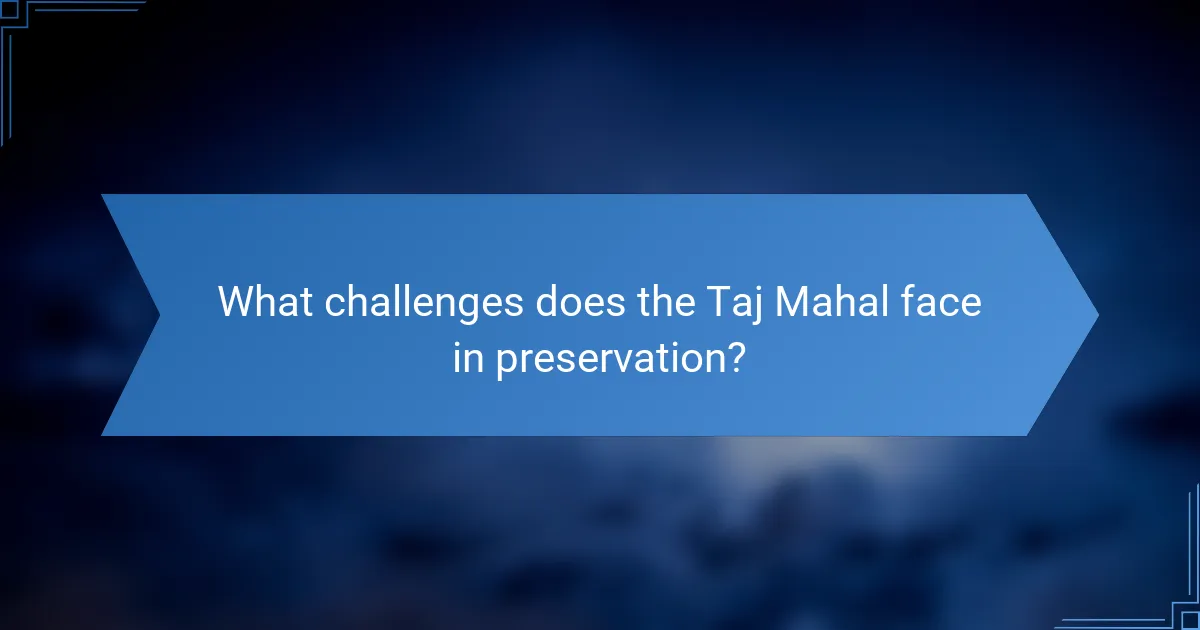The Taj Mahal stands as a testament to Mughal heritage, showcasing architectural brilliance and cultural artistry. This article explores its key architectural features, the role of photography in capturing its beauty, and its significance as a UNESCO World Heritage Site. It also addresses the challenges of preservation and the monument’s influence on global architecture. Understanding these aspects enhances appreciation of this iconic symbol of love and devotion.

What architectural features define the Taj Mahal?
The Taj Mahal is defined by its stunning symmetry, intricate marble inlay, and grand dome. Key architectural features include the use of white marble, a central dome rising to 35 meters, and four minarets. The garden layout follows a Persian charbagh design, symbolising paradise. Its unique attribute is the optical illusion created by the dome appearing larger from certain angles. The monument exemplifies Mughal architecture, blending Persian, Indian, and Islamic styles harmoniously.
How does symmetry play a role in its design?
Symmetry is fundamental to the Taj Mahal’s design, creating visual harmony and balance. This architectural feature reflects the principles of Mughal aesthetics, emphasising order and beauty. The symmetrical layout enhances the monument’s grandeur, with its central dome flanked by identical minarets. This design not only serves an aesthetic purpose but also symbolises the eternal love of Shah Jahan for Mumtaz Mahal. The precise alignment of elements contributes to the overall sense of tranquility and reverence, making the Taj Mahal a masterpiece of Mughal heritage.
What materials were used in its construction?
The Taj Mahal was constructed using white marble, red sandstone, and precious gemstones. The primary material, white marble, was sourced from Makrana, Rajasthan, known for its quality and luminosity. Red sandstone, used in various structures, was primarily obtained from Fatehpur Sikri. Additionally, semi-precious stones like lapis lazuli and jade were intricately inlaid into the marble surface, enhancing its aesthetic appeal. These materials reflect the unique attributes of Mughal architecture, combining beauty with durability.
Which architectural styles influenced the Taj Mahal?
The Taj Mahal was influenced by Persian, Indian, and Islamic architectural styles. Persian elements are evident in its symmetrical gardens and intricate calligraphy. Indian influences appear in the use of local materials and decorative motifs. Islamic architecture contributes through its grand domes and minarets, emphasising harmony and spirituality. The combination of these styles creates a unique representation of Mughal heritage, showcasing the cultural significance of this iconic monument.

How has the Taj Mahal been captured in architectural photography?
The Taj Mahal has been captured in architectural photography as a symbol of Mughal heritage and beauty. Photographers emphasise its intricate details, symmetry, and the interplay of light and shadow. Iconic images often showcase its reflective pool, enhancing its grandeur. Unique attributes like the changing colours at sunrise and sunset add depth to its visual representation. Architectural photography of the Taj Mahal not only highlights its aesthetic appeal but also conveys its cultural significance as a UNESCO World Heritage Site.
What are the best times of day for photography?
The best times of day for photography at the Taj Mahal are during the golden hour, shortly after sunrise and before sunset. These periods provide soft, warm lighting that enhances the intricate details of Mughal architecture. Additionally, early mornings often feature fewer crowds, allowing for clearer shots of this iconic structure. The unique attribute of the Taj Mahal’s white marble reflects varying shades of colour throughout the day, making it a captivating subject for photographers.
Which angles and perspectives enhance its beauty?
Capturing the Taj Mahal’s beauty is enhanced by specific angles and perspectives. Low angles emphasise its towering minarets, while wide shots showcase its reflection in the water. Framing the monument with surrounding gardens adds depth. Close-ups reveal intricate marble inlay work, highlighting craftsmanship. Golden hour lighting enhances the monument’s colours, creating a magical atmosphere. Each perspective offers a unique interpretation of this Mughal masterpiece.
How do seasonal changes affect photographic opportunities?
Seasonal changes significantly enhance photographic opportunities at the Taj Mahal by altering light, colours, and ambiance. In spring, blooming flowers provide vibrant backdrops, while autumn offers soft golden light. Winter fog creates mystical scenes, and summer sunsets add dramatic skies. Each season showcases unique attributes of Mughal architecture, enriching cultural significance through varied perspectives. Photographers can capture the essence of the Taj Mahal in diverse contexts, making every visit a fresh experience.

What cultural significance does the Taj Mahal hold in Mughal heritage?
The Taj Mahal symbolizes Mughal heritage through its architectural grandeur and cultural artistry. It represents the pinnacle of Mughal architecture, showcasing intricate craftsmanship and harmonious design. Built as a mausoleum for Mumtaz Mahal, it reflects the era’s values of love and devotion. The monument’s white marble façade, adorned with precious stones, illustrates the unique attribute of Mughal artistry. As a UNESCO World Heritage Site, it continues to inspire admiration and serves as a cultural emblem of India’s rich history.
How does it reflect the values of the Mughal Empire?
The Taj Mahal embodies the values of the Mughal Empire through its architectural grandeur and intricate artistry. It symbolizes love, power, and the cultural synthesis of Persian, Indian, and Islamic influences. The use of white marble reflects purity and devotion, while the symmetry and gardens represent paradise on earth. These elements collectively convey the Mughal ideals of beauty and harmony, showcasing the empire’s commitment to art and architecture as expressions of its values.
What stories and legends are associated with the Taj Mahal?
The Taj Mahal is associated with several captivating stories and legends. One prominent tale is that of Emperor Shah Jahan’s love for his wife Mumtaz Mahal, for whom the mausoleum was built. Another legend suggests that Shah Jahan intended to construct a second black marble mausoleum for himself across the river, symbolising their eternal connection. Additionally, local folklore claims that the construction involved the sacrifice of artisans, adding a layer of mystique to its history. These narratives contribute to the cultural significance of the Taj Mahal within Mughal heritage.
How is it perceived in contemporary Indian culture?
The Taj Mahal is seen as a symbol of love and a masterpiece of Mughal architecture in contemporary Indian culture. It embodies the rich heritage and artistic achievements of the Mughal era, attracting millions of visitors annually. The monument’s intricate design and historical significance reinforce its status as a national icon. Additionally, it serves as a focal point for discussions on cultural preservation and tourism in India. The Taj Mahal’s representation in media and art further enhances its importance in contemporary society.

In what ways has the Taj Mahal influenced global architecture?
The Taj Mahal has profoundly influenced global architecture through its unique design and cultural significance. Its fusion of Persian, Islamic, and Indian architectural styles has inspired countless structures worldwide. The use of symmetrical gardens, intricate marble inlay work, and domed roofs are now common in various architectural designs. Additionally, the Taj Mahal’s status as a UNESCO World Heritage Site emphasises the importance of preserving cultural heritage, encouraging architects to integrate traditional elements into modern designs. This blend of aesthetics and cultural storytelling continues to shape architectural practices globally.
Which modern structures draw inspiration from its design?
Modern structures inspired by the Taj Mahal include the Bibi Ka Maqbara in India and the Taj Mahal Palace Hotel in Mumbai. The Bibi Ka Maqbara, built in the 17th century, mirrors the Taj Mahal’s white marble and intricate ornamentation. The Taj Mahal Palace Hotel, completed in 1903, showcases Indo-Saracenic architecture, drawing on Mughal elements. Other notable examples are the Shah Jahan Mosque in Pakistan and the Humayun’s Tomb in Delhi, both reflecting Mughal architectural principles. These structures highlight the enduring influence of Mughal heritage in contemporary design.
How has its aesthetic impacted architectural trends worldwide?
The Taj Mahal has profoundly influenced architectural trends worldwide through its unique aesthetic qualities. Its symmetrical design, intricate marble inlay, and harmonious proportions have inspired countless structures globally. The use of white marble and elaborate gardens has become a hallmark of Mughal architecture, promoting an appreciation for beauty and craftsmanship. As a result, modern architects often incorporate elements reminiscent of the Taj Mahal, blending cultural heritage with contemporary design. This enduring legacy highlights the significance of the Taj Mahal as a symbol of artistic excellence and cultural identity.

What challenges does the Taj Mahal face in preservation?
The Taj Mahal faces significant challenges in preservation, including pollution, climate change, and structural deterioration. Airborne pollutants, particularly from industrial emissions, are causing discoloration and damage to the marble. Additionally, rising groundwater levels threaten the foundation, leading to potential structural instability. Efforts to mitigate these issues involve restoration projects and environmental regulations, but ongoing maintenance remains critical for its longevity.
How does pollution affect its structural integrity?
Pollution significantly compromises the structural integrity of the Taj Mahal. The marble surface is particularly vulnerable to acid rain and particulate matter, leading to discoloration and erosion. Over time, these factors weaken the building’s foundation and overall stability. Regular maintenance and pollution control measures are essential to preserve this iconic Mughal heritage site.
What conservation efforts are currently underway?
Current conservation efforts at the Taj Mahal focus on structural preservation and pollution control. The Archaeological Survey of India is implementing restoration projects to address erosion and discoloration. Additionally, air quality monitoring initiatives aim to reduce pollution levels impacting the monument. Collaboration with environmental organizations enhances these efforts, ensuring the Taj Mahal remains a symbol of Mughal heritage.

How can visitors best appreciate the Taj Mahal’s significance?
Visitors can best appreciate the Taj Mahal’s significance by understanding its architectural brilliance and cultural heritage. The Taj Mahal represents the zenith of Mughal architecture, combining Persian, Islamic, and Indian styles. Its intricate marble inlay work and symmetrical gardens symbolise eternal love and devotion. Engaging with its historical context enhances appreciation; it was commissioned by Emperor Shah Jahan in memory of his wife, Mumtaz Mahal. Visitors should explore the site at different times of day to witness the changing light on the marble, revealing its unique qualities.
What are the recommended practices for respectful tourism?
Respectful tourism at the Taj Mahal involves understanding cultural significance and adhering to local customs. Visitors should maintain silence in sacred areas, dress modestly, and avoid littering. Engaging local guides enhances appreciation of Mughal heritage. Supporting local artisans and businesses fosters community respect. Lastly, photography should be considerate, avoiding disruption to other visitors.
Which cultural events and festivals celebrate its legacy?
Cultural events and festivals that celebrate the legacy of the Taj Mahal include the Taj Mahotsav and World Heritage Day. The Taj Mahotsav is an annual festival showcasing traditional crafts, music, and dance, highlighting Mughal heritage. World Heritage Day, observed on April 18, promotes awareness of cultural heritage sites, including the Taj Mahal. These events foster appreciation for Mughal architecture and its historical significance. Additionally, local celebrations during Eid and Diwali often feature the Taj Mahal as a backdrop, symbolising unity and cultural pride.
What tips can enhance the visitor experience?
To enhance the visitor experience at the Taj Mahal, focus on guided photography tours, cultural workshops, and informative signage. These elements provide deeper insights into Mughal heritage and architectural details.
Guided photography tours can help visitors capture the Taj Mahal’s intricate designs while learning about its history. Cultural workshops offer hands-on experiences related to Mughal art and architecture, enriching the visit. Informative signage throughout the site can highlight key features, enhancing understanding and appreciation.
Additionally, consider timing visits for sunrise or sunset for optimal lighting, which enhances photography opportunities and creates a more serene atmosphere.